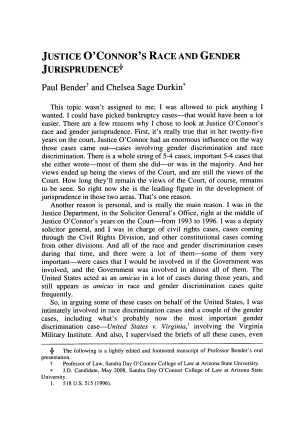Justice O'Connor's Race and Gender Jurisprudence
September 2007

DISCLAIMER: This text has been transcribed automatically and may contain substantial inaccuracies due to the limitations of automatic transcription technology. This transcript is intended only to make the content of this document more easily discoverable and searchable. If you would like to quote the exact text of this document in any piece of work or research, please view the original using the link above and gather your quote directly from the source. The Sandra Day O'Connor Institute does not warrant, represent, or guarantee in any way that the text below is accurate.
Article Text
(Excerpt, Automatically generated)
JUSTICE O'CONNOR'S RACE AND GENDER JURISPRUDENCE *
Paul Bender and Chelsea Sage Durkin*
This topic wasn't assigned to me; I was allowed to pick anything I wanted. I could have picked bankruptcy cases-that would have been a lot easier. There are a few reasons why I chose to look at Justice O'Connor's race and gender jurisprudence. First, it's really true that in her twenty-five years on the court, Justice O'Connor had an enormous influence on the way those cases came out-cases involving gender discrimination and race discrimination. There is a whole string of 5-4 cases, important 5-4 cases that she either wrote-most of them she did-or was in the majority. And her views ended up being the views of the Court, and are still the views of the Court. How long they'll remain the views of the Court, of course, remains to be seen. So right now she is the leading figure in the development of jurisprudence in those two areas. That's one reason.
Another reason is personal, and is really the main reason. I was in the Justice Department, in the Solicitor General's Office, right at the middle of Justice O'Connor's years on the Court-from 1993 to 1996. I was a deputy solicitor general, and I was in charge of civil rights cases, cases coming through the Civil Rights Division, and other constitutional cases coming from other divisions. And all of the race and gender discrimination cases during that time, and there were a lot of them-some of them very important-were cases that I would be involved
